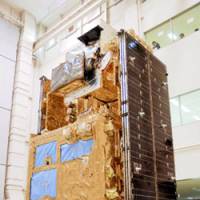A newly launched Japanese satellite is the first ever designed to monitor greenhouse gases worldwide and should help scientists better judge where global warming emissions are coming from and how much is being absorbed by the oceans and forests.
Named Ibuki, which means "breath," the device along with a similar U.S. satellite to be launched next month will represent an enormous leap in available data on carbon dioxide and methane in the atmosphere, now drawn from scattered ground stations.
"I'm saying Christmas is here," said an enthusiastic Inez Fung, an atmospheric scientist at the University of California, Berkeley. "Now, we get about 100 observations every two weeks. With the satellite, we'll get a million."
Ibuki was sent into orbit Friday. Ibuki, which will circle the globe every 100 minutes, is equipped with optical sensors that measure reflected light from the Earth to determine the density of carbon dioxide and methane.
Scientists depend on 282 land-based stations — and scattered instrumented aircraft flights — to monitor carbon dioxide at low altitudes.
Ibuki, orbiting at an altitude of about 670 km, will be able to check gas levels in entire columns of atmosphere at 56,000 locations.
Swiss climatologist Fortunat Joos said the satellite readings may make it possible "to discriminate carbon emissions from different countries."



